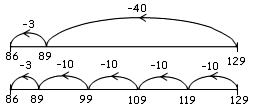Number line subtraction II
This task is about showing how to solve subtraction equations on a number line.
For the questions below show how to solve the equations on the number line.
Read through the example in the box before you start.
Example: Sarah had to solve this problem: 96 –  = 64. = 64.She knew that 96 – 30 = 66, and that 66 – 2 = 64. So she showed this on the number line and then wrote the answer in the box:  |
|
a)
|
Use the number line below to show how to solve the equation: 129 –
 = 86 = 86 |
|
b)
|
Use the number line below to show how to solve the equation: 570 –  = 137 = 137  |
|
c)
|
Use the number line below to show how to solve the equation: 786 –
 = 428 = 428 |
|
d)
|
Use the number line below to show how to solve the equation: 816 –
 = 229 = 229 |






